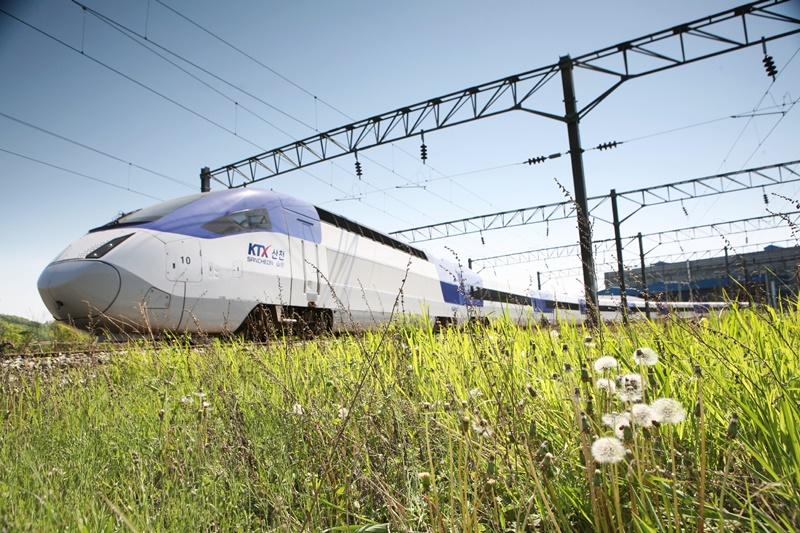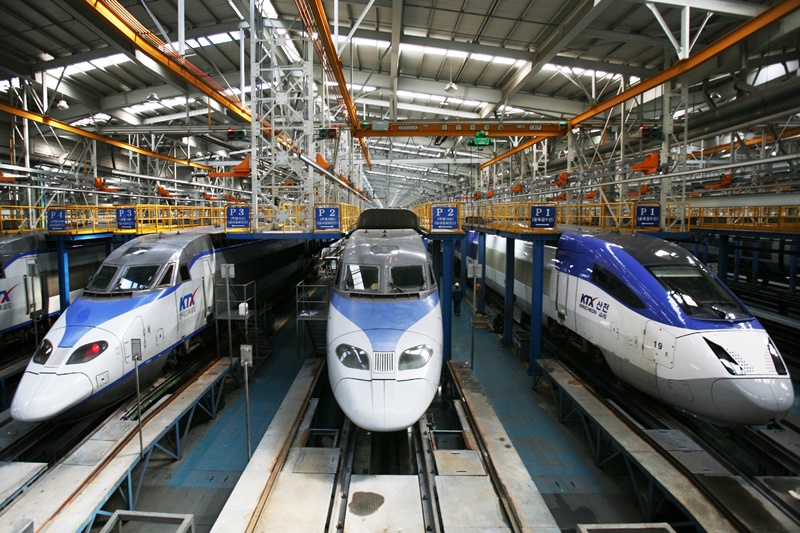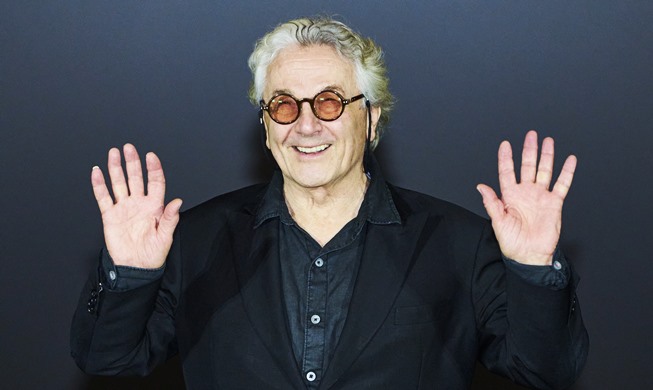-
 Korea.net's 24-hour YouTube channel
Korea.net's 24-hour YouTube channel- NEWS FOCUS
- ABOUT KOREA
- EVENTS
- RESOURCES
- GOVERNMENT
- ABOUT US
- 한국어
- English
- 日本語
- 中文
- العربية
- Español
- Français
- Deutsch
- Pусский
- Tiếng Việt
- Indonesian

The bullet train Korea Train eXpress (KTX) on April 1 marked its 20th anniversary, with its number of passengers on Aug. 31, 2023, surpassing the billion mark, equal to more than 20 rides by every member of the national population. Shown is the domestically developed model KTX-Sancheon, which runs through mountainous terrain.
By Wu Jinhua and Lee Kyoung Mi
Photos = Korea Railroad Corp.
The nation's bullet train Korea Train eXpress (KTX) on April 1 marked the 20th anniversary of its launch as a form of transportation that nearly every citizen has used once.
The number of passengers on the KTX in late August last year surpassed the billion mark, or equal to over 20 rides per every member of the national population. By enabling travel to every corner of the country within two hours, the KTX has dramatically transformed daily life and culture for the public.
The country's first high-speed train was launched in 2004 to more evenly distribute surging demand for roads after the opening of the Gyeongbu Expressway in the 1970s.
Under continuous evolution, the KTX had its first train use the technology of French rolling stock maker Alstom. Later, domestic scientists helped develop the train and raise its technological capacity, leading to the debut of the domestically developed KTX-Sancheon in November 2008.
This made Korea just the fourth country to independently manufacture a high-speed train. January 2021 saw the release of KTX-Eum, a new propulsion system for the bullet train, followed by the release on April 1 this year of the next-generation eco-friendly model KTX Cheong-ryong, whose top speed is 320 km per hour.

KTX and KTX-Sancheon trains await delivery after maintenance.
Technological advances have expanded the operating area of the KTX. The bullet train first provided service on the Gyeongbu Line connecting Seoul and Busan and the Honam Line between Seoul and Gwangju and Mokpo with a combined 20 stops.
The KTX now covers eight lines including Gangneung, Jungang (Central) and Naeryuk (Central Inland) with 69 stations. The daily number of trips has jumped from 142 to 381 and the number of trains has expanded from 46 (828 cars) to 103 (1,414).
November 2012 saw the debut of Korail Talk, the renamed app of the Korea Railroad Corp. (Korail) that allowed digital ticketing. As of last year, tickets made through the app comprised over 86% of all issued.
As of last year, KTX trains had covered a combined 630 million km, or enough to circle Earth 15,700 times. The distance traveled by the bullet train's passengers was 258.6 billion km, or 1,724 times the distance between Earth and the sun.
Korail said the number of KTX passengers surpassed a million just 14 days after the first whistle blew on April 1, 2004, to launch KTX's inaugural operation. This was faster than high-speed trains in Europe such as those in France and Spain (three months) and Japan's Shinkansen (16 days).
Last year, the average daily number of KTX users was 229,000, more than triple the 72,000 in its first year.
"We will strive to lead the future of transportation through digital innovation and development of key human resources," Korail President and CEO Han Moon-Hee said. "Since many foreign visitors use the KTX, we ask for your interest as we expand services such as QR code ticketing and links with air travel."
| Tips for foreign users of KTX - Foreign travelers riding the KTX should use the Korail Pass, which is exclusively for foreign nationals and available on the multilingual website Let's Korail (https://www.letskorail.com/ebizbf/EbizbfForeign_pr16100.do?gubun=1) or at designated outlets like travel centers at stations and Korail-designated travel agencies. With the exception of Super Rapid Train and temporary tourist trains, the pass allows unlimited access to standard seats on the KTX, with the option to reserve seats up to twice a day. - Chinese tourists can utilize Korail's ticket reservation service through online platforms such as Alipay and the mobile app of WeChat. Such platforms can handle everything from train information to seat selection, payment and ticket confirmation. - Foreign users need not worry over difficulties using Korail Talk. Use of the expat reservation QR code feature directly links to the Let's Korail website without the need to install a separate app. Such codes are mainly deployed around ticket counters and automated ticket machines at 50 major stations frequented by foreign travelers such as in Seoul and Busan. Moreover, the website allows easy ticket purchase using foreign credit cards. |
jane0614@korea.kr
Most popular
- First hearing-impaired K-pop act hopes for 'barrier-free world'
- 'Mad Max' director impressed by 'cinema-literate' Korean viewers
- Romanian presidential couple visits national cemetery
- President Yoon, Japan PM pledge better trilateral ties with US
- President, Romania pledge better defense, nuclear power ties













